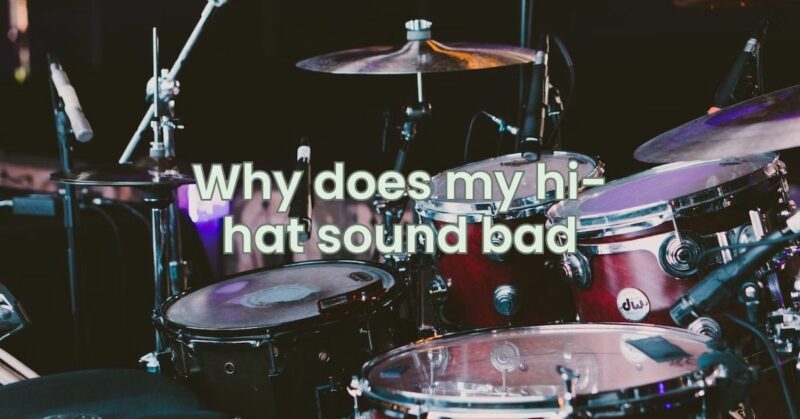The hi-hat cymbals are a cornerstone of a drum kit, contributing rhythmic texture and dynamic character to your playing. However, encountering a poor-sounding hi-hat can be disheartening for drummers. The sound quality of your hi-hat is influenced by various factors, and understanding why it might not meet your expectations is essential for enhancing your overall drumming experience. In this article, we’ll delve into the potential reasons behind a lackluster hi-hat sound, how they manifest, and steps you can take to address the issue and restore the vibrancy to your cymbals.
Decoding the Dullness:
A poor-sounding hi-hat can manifest in various ways, such as a lack of clarity, unwanted overtones, or an inconsistent response. Pinpointing the specific aspects that contribute to the undesirable sound is crucial for effective troubleshooting.
Common Reasons for a Poor-Sounding Hi-Hat:
- Cymbal Quality: The quality of the hi-hat cymbals themselves significantly affects the sound. Inferior or damaged cymbals may produce a dull or undesirable tone.
- Misalignment: If the hi-hat cymbals are not properly aligned or sit unevenly on the stand, it can lead to inconsistent sound and poor response.
- Tension and Pressure: The tension of the hi-hat clutch and the pressure applied by the foot can impact the sound. Excessive tension or uneven pressure can affect the cymbals’ vibration.
- Cymbal Positioning: The position of the cymbals on the stand, as well as their proximity to each other, can affect the sound. Incorrect positioning can result in undesirable overtones or a muffled tone.
- Dirt and Residue: Dust, dirt, and residue can accumulate on the cymbals over time, dampening their vibrations and affecting the sound quality.
- Inadequate Stand Stability: An unstable or wobbly hi-hat stand can impact the cymbals’ movement and disrupt their natural resonance.
Steps to Improve Hi-Hat Sound Quality:
- Assess Cymbal Quality: If the cymbals are of poor quality or damaged, consider upgrading to higher-quality cymbals that resonate better and produce a clearer tone.
- Align the Cymbals: Make sure the hi-hat cymbals are properly aligned and sit evenly on the stand. Adjust the tension of the clutch to ensure proper contact.
- Adjust Clutch Tension: Experiment with the tension of the hi-hat clutch to find the sweet spot that allows the cymbals to vibrate freely and produce a desirable tone.
- Check Cymbal Positioning: Ensure that the cymbals are positioned at the appropriate distance from each other and are not touching when closed.
- Clean the Cymbals: Regularly clean the cymbals with a cymbal cleaner to remove dust, dirt, and residue that can dampen vibrations and affect sound quality.
- Stabilize the Stand: Make sure the hi-hat stand is stable and secure. Adjust the stand’s legs and base to eliminate wobbling or movement during play.
Conclusion: Rediscovering Hi-Hat Brilliance
A poor-sounding hi-hat doesn’t have to be a permanent setback in your drumming journey. By understanding the factors that contribute to the lackluster sound and taking proactive steps to address them, you can rediscover the brilliance and vibrancy of your hi-hat cymbals. Whether it’s assessing cymbal quality, aligning cymbals properly, adjusting clutch tension, or maintaining clean surfaces, remember that every action you take contributes to enhancing your drumming experience. As you embark on the quest to improve your hi-hat sound quality, you’re not just fine-tuning an instrument—you’re immersing yourself in the art of sound sculpting, ensuring that each strike of the cymbals resonates with clarity, definition, and musical expression.


